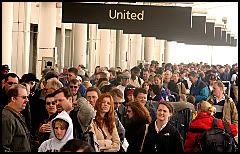The Liminal World
In this "liminal" world, a place of "between and betwixt" we are searching for signs and symbols that when everything is said and done, that, the life we lead will provide us our own salvation and "personal bliss" so that we can find paradise in the liminatlity aspect of our own personal lives and narratives. Therefore, this website will be dedicated to the showing of: how different cultures and peoples’and their own personal narratives affect their daily lives navigate The Liminal World.
Friday, February 23, 2007
A REDESIGNED WORLD---COME VISIT
Thursday, February 22, 2007
Single Ladies Please read!
By MARIA CHENG
(AP) Scientists say conclusive data shows there is no question circumcision reduces men's chances of...
LONDON (AP) - Scientists say conclusive data shows there is no question circumcision reduces men's chances of catching HIV by up to 60 percent - a finding experts are hailing as a major breakthrough in the fight against AIDS. Now, the question is how to put that fact to work to combat AIDS across Africa.
The findings first were announced in December, when initial results from two major trials - in Kenya and Uganda - showed promising links between circumcision and HIV transmission. However, those trials were deemed so definitive that the tests were halted early.
The full data from the trials, carried out by the United States' National Institutes of Health, were published Friday in The Lancet.
"This is an extraordinary development," said Dr. Kevin de Cock, director of the World Health Organization's AIDS department. "Circumcision is the most potent intervention in HIV prevention that has been described."
Circumcision has long been suspected of reducing men's susceptibility to HIV infection because the cells in the foreskin of the penis are especially vulnerable to the virus.
A modeling study done last year projected that in the next decade, male circumcision could prevent 2 million AIDS infections and 300,000 deaths. Last year, 2.8 million people in sub-Saharan Africa became infected with HIV, and 2.1 million people died.
Experts say the breakthrough is a significant one on par with the identification of the virus and the use of lifesaving combination drug therapy.
The two U.S. studies confirm similar results from an earlier trial in South Africa. Given the recent failure of a microbicide trial in Africa and India, and the ongoing difficulties in developing an AIDS vaccine, the potential of circumcision as a new weapon against HIV has become even more significant.
But they caution solid evidence is not justification for mass circumcisions.
African health systems are already overburdened. Circumcision requires much more planning than, for example, an immunization campaign.
"It's a tricky one, but it's something we're going to have to move on," said Dr. Catherine Hankins, a scientific adviser at UNAIDS.
"Male circumcision is such a sensitive religious and cultural issue that we need to be careful," she said.
Several African countries have already met with U.N. agencies to explore new strategies for increasing circumcision services. Swaziland, for instance, recently experimented with a series of "Circumcision Saturdays," where existing health care facilities, normally closed on weekends, were opened by local doctors to circumcise approximately 40 men a day on certain Saturdays.
Providing circumcisions across Africa would not be the first time surgical procedures have been adopted by public health campaigns.
"Cataract surgeries have been carried out extremely efficiently to prevent blindness worldwide," said Dr. Richard Hayes, an AIDS expert at the London School of Hygiene and Tropical Medicine. In some places, the cataract surgeries are performed by trained paramedics.
In recent years, the fight against the AIDS pandemic has focused on the provision of lifesaving drugs. The circumcision data gives prevention, rather than treatment, renewed emphasis.
"Treating people with antiretrovirals is completely unsustainable unless we can turn off the tap of infection," said Hayes.
While circumcision may offer new hope, it is not a cure for the epidemic.
"This is an additional tool, and it must not replace other interventions," said de Cock, who added that there will be no push for universal circumcision. "There is no one size fits all solution for AIDS."
Together with the United Nations AIDS agency, WHO is convening a meeting in Switzerland in early March to evaluate the circumcision data, and to decide on the next steps in slowing the AIDS pandemic.
In the Kenyan study, 1,391 circumcised men were compared to 1,393 who were not. And in Uganda, 2,474 circumcised men were compared to 2,522 men who were not. After tracking the men for two years, scientists found that circumcised men were 51 to 60 percent less likely to contract HIV than their uncircumcised counterparts. Since the studies were stopped, all the men have been offered the opportunity to be circumcised. And all the men were warned not to lapse into sexually risky behavior, such as abandoning condom use.
Scientists theorize that women would benefit indirectly from lower HIV prevalence in men, and a study is currently ongoing in Uganda to determine this.
In areas where HIV is spread primarily through heterosexual sex, such as sub-Saharan Africa, male circumcision could theoretically slash the infection rate in half.
It is unknown whether circumcision would be equally effective in concentrated AIDS epidemics, as in Asia and eastern Europe, where AIDS primarily strikes gay men and drug users.
A REDESIGNED WORLD---COME VISIT
Saturday, January 27, 2007
Part Three—Celebrity, Choices, Friends: A Study of Gang Culture (Death of Darrent Williams)
 There is an unwritten code; failure to conform to the group means one’s death. In the real world failure to conform meant to be branded as deviant, or as a troublemaker, or as a weirdo who is living outside “the normative” (what is normal) of society. Or the same deviant can be seen as innovative, groundbreaking, entrepreneurial, in that, the individual is seen as a hero. Or there is a possibility that can be in the crossroads of transition, betwixt and between; sometimes this status can be instantaneous, or either, a long conversion.
There is an unwritten code; failure to conform to the group means one’s death. In the real world failure to conform meant to be branded as deviant, or as a troublemaker, or as a weirdo who is living outside “the normative” (what is normal) of society. Or the same deviant can be seen as innovative, groundbreaking, entrepreneurial, in that, the individual is seen as a hero. Or there is a possibility that can be in the crossroads of transition, betwixt and between; sometimes this status can be instantaneous, or either, a long conversion.
“lawful” acts in providing one’s skill and knowledge.
These cultural worlds are overlapping and are and was spoon-fed to us—as it was to Darrent Williams. In William’s youth, choices made by were susceptible by the lack of leadership and parentage of a father being present. One of the decision (according to hegemony) is the having children out of wedlock at the early age of sixteen. This is where one of his most vocal critics comes into play—Steve Seidenfeld, of
(End part three)
Thursday, January 18, 2007
Two Days After-Part Two; Darrent Williams: A Study of American Gang Culture
Two days after Darrent Williams death, a Denver Bronco, an American football player, was shot and killed, Denver Radio talk show hosts bombarded the airways, trying to figure out what happened. Two individual in particular stuck out: Peter Boyles of


This lack of foresight has made the city a dangerous place for witnesses. Public, very public drive bys-yet “no proof” or witnesses are invisible. The crips, the bloods, the ms13, to some extent, have quietly ruled the roost of Denver Metropolitan streets. However, let me not leave you with the impression that
Arguments were made by Boyles that the intimidation by the gangs was keeping silent the witnesses, he also asserts that “music” of gang-banger hip-hop was some how encouraging children, minority children, to embrace the violence. In essence, the music instills the disrespect, the “villainizing” of authority, and the emboldening of cultural power through violence. In that, the only way to gain respect is through one’s violent acts—to gain “props.” Essentially, to prove one’s manhood is to either withstand perpetrated acts against oneself, or to perpetrated an act themselves. But there is darker side, a greater illusion, is that, gang culture believes that, through fear and intimidation that they can usurp authority. The second illusion gang culture tries to foster is a sense of family. The gang will take care of you. We will be the parent, the disciplinarian, the trust your own parent/s never gave you. As Boyles puts it, “don’t bet on it…”
Peter Boyles probing statement throughout the cadre of shows,” It is what, what it is”; or his other profound statement, “What does this mean?” Well, those are certainly statement and inquiries. He later parlays this tragedy into debate regarding illegal immigration. This is certainly an interesting perspective.
(End part two).
Photo credits of Darrent Williams is from his Myspace.com page and image of the limousine is from AP photo from a written article by Foxnews.
Sunday, January 14, 2007
Darrent Williams: A Study of American Gang Culture—Part One

Let me begin this way, by way of an admission, when I first heard about Darrent Williams, a Denver Bronco, an American footbal player, being shot, the farthest thought from my mind was that, his death was gang involved. In fact, I chastised a fellow blogger for bringing it up; and, for the record, I still would. I chastised them for it, because speculations were made before the facts were in.
photo credit by AP
Sunday, January 07, 2007
Let It Snow, Let It Snow, Let it Snow!
 The above words are from a traditional Christmas song often heard ad nauseam leading up to the very day, and thankfully dissipates afterward as the new year approaches. Well, the sentiment of it of snowing prior was brought forth, however, only days before Christmas in my hometown of Denver, Colorado.
The above words are from a traditional Christmas song often heard ad nauseam leading up to the very day, and thankfully dissipates afterward as the new year approaches. Well, the sentiment of it of snowing prior was brought forth, however, only days before Christmas in my hometown of Denver, Colorado.The city, state, and the airport, Denver International Airport, which is 30 miles outside city limits, were brought to a stand still. The snow fell from the sky, growing higher, like a steady stream of water, ready to overflow. The wind blew, cars slipped, buses skewered sideways, down the streets as the day grew late. Our state planners, our city planners, and mayors, statewide, urgently, valiantly (ahem) tried to illustrate (and implement), that they had a plan. It (the plan) and they failed.

Not as costly as Bush-Rumsfeld-Iraq stay the course plan—in fact—not even close, but it failed. The storm cyclone its way across the mountains first, obviously, then backed up into the valley of Denver, and then across the eastern plains of Colorado. The radar screens of the hyper-excited weatherpersons looked like a hurricane on land. Inch by inch the overjoyed, seemingly, weather generals, the sexiest of them Kathy Sabine, had command, albeit short lived of the news and newscast.

The storm’s intensity gave the brave at heart pause; and, the foolish the moments for their stupidity, while the dedicated made their way to work—by any means necessary.
By mid-afternoon of the second day, cars went abandoned, bus service halted, even Denver’s “heralded” light rail choked, puttered to a stop. City and a state plows raced to the cities—and roads of the state. Their attempts were futile. Airport runways, taxi ways, exit ramps, the equivalent of a city, laid dormant.

Mere days following after the storm, critics began to pick on the carcasses of the politicos failure. It was as if they, the critics, took glee from the “state emergency” by giving them permission to cascade all their pent up venomous vitriol at the leaders of the cities and state. This whipped the public into whine and what about me mode. They decried the inconvenience and how the plows failed to come down their streets during the storm.

Passengers, at the airport, from all stripes, family with children, individuals curled in corners, asleep, waited to join their anxious family members and friends across the country.
Of course, no one had seen such a storm since the “blizzard of 1982”, or the abruptness of the storm “spring of 2003.” No, this storm was different; it left cars scattered—and adrift in snow. People in shelters trying to find warmth—and comfort as the Red Cross did its duty. The spirit of community and togetherness lasted as long as the clouds and blue sky were obscured.

Slush filled streets, which refroze nightly, greeted vehicles and pedestrians alike in the daily melt down. Cars splashed. Pedestrians stumbled, staggered, and slipped along side streets, main roads, and thoroughfares. Stepping over high drifts, falling in indiscernible sink holes as locals tried to return to the daily grind.
No, this storm was different yet the same. It reminded us, how vulnerable we are; how spoiled we are; how powerless we are in the face of nature; and, how we take things for granted as Mother Nature—yet again reminded us, like little children, who have forgotten their manners that she has command over us and always will.
All photos are by Site Administrator, except the United Airlines terminal which is done by George Kochaniec, Jr. © Rocky Mountain News, and stock photo of airport by Photovault Aviation Museum
Monday, January 01, 2007
Let Green Business be the Grinch

It is a new way of doing business. A new a type of currency, a new energy to be resourced, and it relies on an old tradition called the barter system. Essentially, I will do “X” for you, if you will “X” for me. Renamed, “Connectory,” allows businesses and individuals with something to sell or market, to exchange services in the forms of credits to have access to “local resources.”
In essence, to keep the local dollar with neighborhood, city, or state, it is a network of businesses, which embolden the philosophical idea of the local community first. Instead of “outsourcing” the dollar out f the sphere of local influence, it brings together, the talents within the community at a commodifed price in for the form of bartered price credits.
It also sets the “Connectory” and “customers” along the same path. As the purveyors of products, the consumption of doing business and doing the customers requires the necessity of talents—and adaptation of the “green consumer market.” This formula requires innovation as well; as this new form business seems to be taking hold in sweeping ethics in how the environment is treated.
This is what I mean, in the “green integral politics,” is having businesses adapt the practice/s of the how they use resources such as energy. For instance, Belgium Brewing Co., a local
By Belgium Brewing using windmills, to power their plants, it has contributed to the reallocation of resources—and energy transmissions. Essentially, they are not overtaxing, or overusing the energy from the power grid to make, or market their product.
But to return to the subject at hand, “green integral politics on small business is beginning to pave the way, at the least, the grassroots, to find support at the market place for the post-modernist environmentalist searching for a new way to be responsible. These companies try to establish themselves as leaders of conscious. They try to “integrate” all four quadrants in the political dynamic model: Upper left (individual emotion) and Upper right (individual behavior) as the lower left (social peer group that establishes cultural mores) and the lower right (which establish the rule of law and governmental systems) and evolving a global citizen.
By the combing of resources, such as sharing office space, networking with other business through the bartering for services on an alternate currency known as credits give power plants to redistribute energy transmissions elsewhere making for a more efficient use of the plants power.
In addition, referred to earlier as “Connectory,” a repackaged name for networking, part of this is an organization called MDB. They will help you, for a small membership fee, services to enhance cash flow, increase sales, reach new customers, and help reduce cash expenses. The Micro Business Development (MDB) group does this as way to keep local dollars in the community as well as offering lines of credits, merchants, and other global green integral corporations.
Nevertheless, the competition of green individual and/or corporation will be at the suffrage of globalization politics. This brand of diversity, innovation, and creativity will be a small subset of the globalized world—but as these companies compete and contribute to the betterment of—and for the environment, they will realize the inevitable conclusion that no matter how much one tries to localize community—one is still part of the global citizenry.
Finally, as for the feeling like fish out of water, out of place, and the impression of being at an Amway meeting, this emotion will soon pass; however, I doubt the Amway feeling will though.
